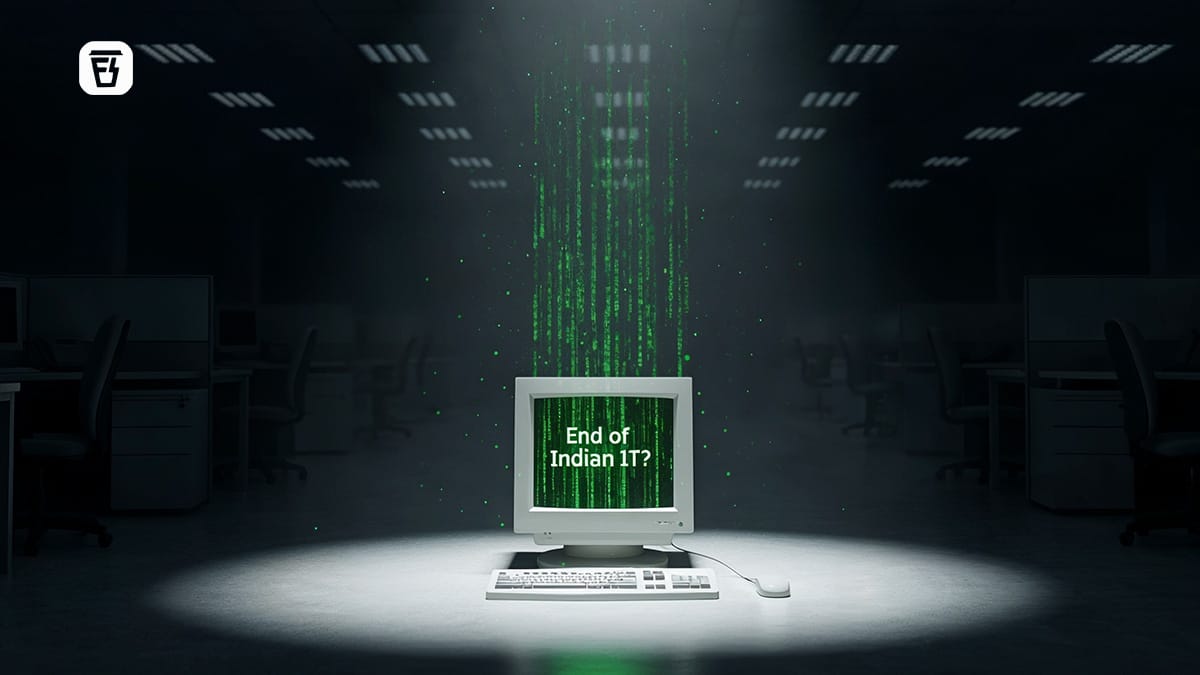Is this the end of the Indian IT Industry?

In today’s Finshots, we trace a season of IT layoffs and talk about the quiet rise of in-house tech hubs that challenge India’s $250-billion outsourcing machine.
The Story
Just three days ago, Tata Consultancy Services (TCS) confirmed it could let go of up to 12,000 people this year, which is roughly 2% of its global headcount. Salary hikes were also put on hold, and lateral hiring was frozen. This felt like a tremor in a company long known for Tata’s legacy and lifetime employment. And anyone holding the stock discovered it had delivered roughly zero return over the last four years.
At the same time, HCL announced that junior employees get only a token 1-4% raise in salary, while mid-level employees have yet to get any. Infosys, the once voracious campus recruiter, onboarded just 210 people last quarter. Revenues across the top Indian vendors are flat or falling in terms of USD, and every earnings call blames it to a cocktail of AI automation, tight US tech budgets, and plain old price pressure.
But, you see, none of that pain is uniquely Indian.
Because Microsoft is also laying off thousands of people in its Azure cloud unit. Intel is laying off 24,000 workers and halting major capital expenditures. And AWS is also laying off hundreds of workers.
So why are tech companies letting go of so many employees?
You see, code-generation tools can now write boilerplate code in minutes. AI agents can automate repetitive workflows, pull real-time updates, and even coordinate things across teams. In other words, a large chunk of what mid-level employees used to do, especially in tech and operations, can now be done faster, cheaper, and more consistently by machines.
But when it comes to the Indian IT industry, it’s not just AI automation that is affecting revenues. The shock lies in the juxtaposition: while headline layoffs mount in legacy outsourcing, multinational clients are quietly expanding their Global Capability Centres (GCCs), within India.
For the uninitiated, a GCC is when a large MNC sets up its own legal entity within the country, hires its own engineers, and runs the same SAP upgrade or data-science sprint that it once paid TCS or Infosys to handle.
So when a Fortune 500 firm sets up a GCC in Bengaluru or Chennai, they don’t just save costs. They also avoid vendor delays, gain ownership over proprietary tools, and have strict data controls. In many ways, it’s vertical integration. And given enough volume, vertical integration always saves costs. Apart from this, throw in an office badge that says “Google” or “Microsoft”, instead of “TCS” or “Infosys”, and you see the appeal, don’t you?
This is why the GCC ecosystem grew about 40% in the financial year 2024 while service-based IT firms eked out less than 5% growth. In fact, these GCCs are expected to grow this year even more than they did in 2024.
At the same time, India is becoming more expensive. As the economy grows and wages rise, so do the costs of operating here. This wouldn’t be a problem if India were the only option. But countries like Vietnam, the Philippines, and even Mexico are offering competitive talent at lower prices. So, if a global firm wants cheap services, they have plenty of options. And if they want quality and control, they have GCCs. The middle ground, where Indian IT vendors once ruled, is slowly vanishing.
That leaves traditional IT companies squeezed from two directions.
Some folks go as far as to say that Indian IT companies are just glorified HR firms, moving people around from one project to another. That might sound a bit too cynical. But the truth is that most of these firms haven’t built products. They’ve built billing engines. They charge clients by the hour, based on how many people they assign to a project. The problem? That model works only as long as human effort is essential. When machines start doing the job 24x7, billing by the hour becomes a liability.
But the obituaries can wait. For now.
You see, Infosys, for instance, is still planning to hire 20,000 freshers this year. And unlike its peers, it actually saw decent revenue growth in the latest quarter. That makes it a bit of an outlier in the current environment. It shows that large deals are still being signed and that traditional outsourcing is not completely dead.
And then there’s Zoho.
This Chennai-based company has quietly built a suite of world-class software without relying on any external investors. It controls everything, from product development to cloud hosting. And it has managed to do it profitably. More importantly, Zoho owns its IP (intellectual property) and doesn’t just offer services that can be replicated or automated. It builds tools that solve real business problems. And those tools are hard to replace.
That’s the direction Indian IT firms will likely need to move toward. Because services can be copied. They don’t offer margins. And they don’t offer pricing power. Products, on the other hand, come with a moat. Sure, they can be copied. But if you can build something that works well and solves a pain point for clients, you can keep charging a premium for it year after year.
Of course, shifting from services to products is easier said than done. It takes a different culture, a different structure, and a whole lot of patience. You can’t pivot a 100,000-person services company and the entrenched culture overnight.
Sure, IT firms might lose clients in the short term and face lower margins. And investors may not like that. But the question is not whether the transition is hard. The question is whether it is necessary.
Because if Indian IT companies want to stay relevant in the coming decades, they might have to stop being service providers and start being product-led. They might have to let go of the old playbook and write a new one. One that isn’t just about billing hours, but about building value.
And if they don’t, someone else will.
Until then…
If this explainer helped you see the future of Indian tech a shade clearer, share it via WhatsApp, LinkedIn, or X and help a friend decode the future of this industry in under three minutes.
🔊Introducing Pitch Perfect 2025!

If you've been following us for a while, you know our story didn't begin in a corporate boardroom. It started in a college dorm room with 3 broke students who chose to skip placements and chase something bigger.
That something was Finshots.
Today, Finshots reaches over 500,000 readers, and through Ditto, we've empowered 800,000+ Indians to make smarter insurance decisions.
Now, we're looking for the next game-changing idea to back.
Introducing Pitch Perfect 2025 – a flagship startup pitch challenge powered by Zerodha.
So, if you've got a BIG idea that could help Indians get better with money, pitch it to us!
What's at stake:
✅₹10,00,000 in prizes
✅Potential funding from Zerodha Rainmatter
✅All-expenses-paid trip to Bangalore to pitch directly to Nithin Kamath and industry veterans
Ready? 👉Apply Now!
